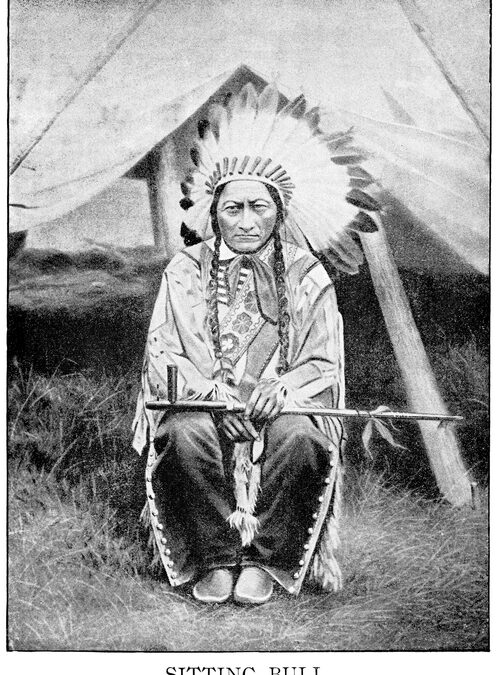Sitting Bull was the leader of the Hunkpapa, a division of the Sioux Indians. There were some Blackfeet and Cheyenne allied with him on the fateful day of June 25, 1876. It would come to be known as the Battle of the Little Bighorn River and Custer’s Last Stand.

But let’s back up. Sitting Bull had promised Wakan Tanka, the supreme being of the Hunkpapa Sioux, a “scarlet blanket,” meaning fifty pieces of flesh from each arm.
Sitting Bull had been warning his people against the temptation offered by the white invaders – food and clothing if they stayed on their respective reservations. Rejecting the guidance of Sitting Bull, the Sioux slowly submitted to the free provisions.
Long knifes (soldiers with swords) were patrolling near the Black Hills, an area held to be scared by a number of First Nations peoples. But gold had been discovered there resulting in a flood of white men overrunning their sacred space.
Knowing that a battle was on the horizon, Sitting Bull sought the help of his deity, Wakan Tanka. Sitting Bull made a vow – to give Waken Tanka 50 pieces of flesh out of each of his arms. This was his atonement; his appeal for help in the coming battle.
So it was that his adopted brother, Jumping Bull, was at his side, using a razor-sharp awl to cut the promised flesh. Starting with Sitting Bull’s left arm, just above the wrist, and working up toward his shoulder, Jumping Bull cut 50 piece of flesh the size of a match head.
Soon Sitting Bull’s arm was flowing with bright, red blood as he cried to Wakan Tanka that he and his people “wanted to be at peace with all, wanted plenty of food, wanted to live undisturbed in their own country,” but knew that war was on the horizon.
Moving to the right arm, Jumping Bull removed 50 pieces of flesh. Then Sitting Bull rose to dance. For a day and a night, he danced the traditional sun dance. I think it was an attempt to achieve a frenzied state of ecstasy through which he would receive a vision of the battle.
About noon on the second day – after many hours without food or water — he began to stagger. Black Moon and Jumping Bull rushed to his side and carefully laid him down on the ground and sprinkled water over him.
He revived and announced that he had seen a vision. Just below the searing disk of the sun, he had seen large numbers of soldiers and horses, along with some Indians, falling upside down in a village “like grasshoppers.” In addition to this prediction of victory over the long knives, a petroglyph supposedly appeared on a flat stone which showed “a bunch of soldiers with their heads hanging down.”
Assured of victory, the Lakota Sioux were confident.
Sitting Bull’s self-torturous atonement had brought the vision of victory. Somehow people feel they must atone (pay) for what they want in such a manner. Somehow we feel that sacrifice must be made.
The Living God of the Bible also required fresh and blood. But He Himself provided it. God Himself became a Man and offered Himself to atone for the sins of humanity. And whereas Sitting Bull went on the kill 700 American soldiers at the Battle of the Little Bighorn, Jesus Christ, the God-Man, died to appease the anger that the Living God feels toward our sins. He atoned for both writer and reader. Do not ignore the atonement of the Lord Jesus Christ. As God in a human body, His atonement was not just for one battle, but for the battle that Christians wage against the sin within themselves on a daily basis. His atonement brings redemption to all mankind who will accept it.
Sources: Nathaniel Philbrick’s The Last Stand


Recent Comments